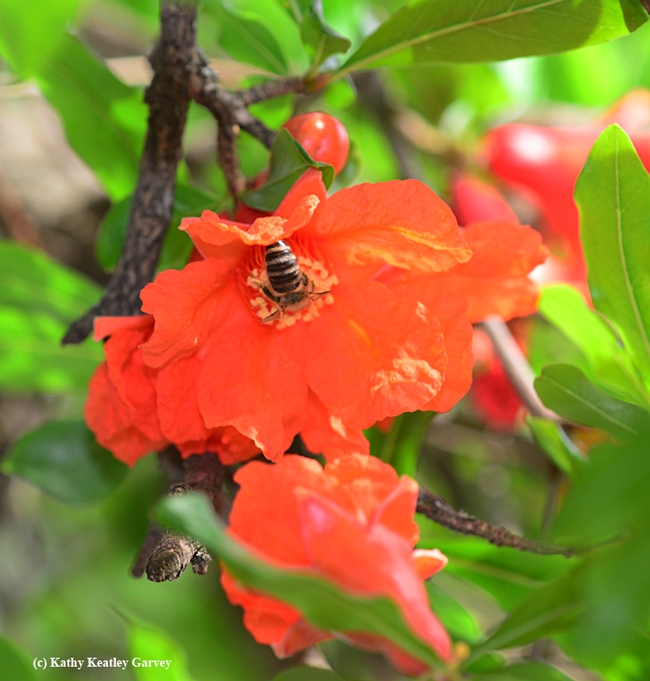Posts Tagged: crisis
Why They're Cautioning: 'Use Antimicrobials Wisely'
UC Davis evolutionary ecologist Scott Carroll and colleagues are on a mission. When the United Nations meets Sept. 21 in New York, they want the UN...

The malaria mosquito, Anopheles gambiae. Evolutionary ecologist Scott Carroll and colleagues point to a World Health Organization paper indicating that malaria is one of the diseases that "can no longer be cured with many older antibiotics or medicines." (Photo by Anthony Cornel, UC Davis)
Bee Crisis Explained
As honey bees go about their bee-ness, foraging among the pomegranate and other blossoms here in California, internationally recognized entomologist...

Honey bee foraging on a pomegranate blossom. (Photo by Kathy Keatley Garvey)

Bottoms up! Honey bee delves deep into a pomegranate blossom. (Photo by Kathy Keatley Garvey)
Bees in Crisis
A few months ago I wrote an article about the importance of planting bee-attracting plants in our gardens to hopefully counteract the alarming effects of Colony Collapse Disorder in the bee population across our country. In my research for that article I learned about neonicotinoids, which are a new type of pesticide suspected of contributing to that disorder. Since then I have read several new pieces, done more research into the topic and learned some worrisome information. Let me share some of that with you.
Firstly, some background: according to Wikipedia, "Neonicotinoids are a class of neuro-active insecticides chemically similar to nicotine. The development of this class of insecticides began with work in the 1980s by Shell and the 1990s by Bayer.[1] The neonicotinoids were developed in large part because they show reduced toxicity compared to previously used organophosphate and carbamate insecticides. Most neonicotinoids show much lower toxicity in mammals than insects, but some breakdown products are toxic.[2] Neonicotinoids are the first new class of insecticides introduced in the last 50 years, and the neonicotinoid imidacloprid is currently the most widely used insecticide in the world.[3] The neonicotinoids include acetamiprid, clothianidin, imidacloprid, nitenpyram, nithiazine, thiaclopridandthiamethoxam." And Dinotefuran.
The connection between these products and the death of so many bees is becoming more widely suspected. In a July edition of "The Hill", it was reported that H.R. 2692- Saving America's Pollinators Act of 2013 had been introduced into Congress, to stop the use of these pesticides and require the EPA to do more extensive research into their effects. (http://thehill.com/blogs/congress-blog/energy-a-environment/312023) It was sent to committee on July 16th and there it has sat. In a January, 2013 report of the European Food Safety Authority neonicotinoids were identified as a definite risk to honey bees. The EPA reported that beginning in December of 2013 and for 2 years forward the use of these pesticides will be severely restricted in Europe. But not here.
In searching the Internet I found that neonicotinoids are in a large variety of products, which may be purchased in stores around town and on such sites as Amazon.com and ebay. Those products include (but I'm sure are not limited to): sprays for insect control of lawns and turf grasses; pesticidal products (sometimes combined with fertilizers) for vegetables and fruits, (citrus fruit, grapes, cotton, canola, cereals, cherries, cucumbers, melons, onions, peaches, rice, stone fruit, strawberries, sugar beets, tea, tobacco, pears, apples, peppers, plums, potatoes, tomatoes) house plants and ornamentals; insecticides to kill bed bugs, leaf miners, grubs, aphids, white flies and beetles; and pet supplies to kill ticks and fleas. So, yes, they are everywhere.
Just as with any other pesticide, there may be good reason to use them at times, but the less we use the better and we certainly want to know if they are in the products that we are buying. So reading labels and steering clear of the ingredients mentioned above should be a pretty effective means by which to feel confident about our purchases. You would think.
However, it has recently been reported that some of the plants sold in "big box store nurseries" are grown from seeds pre-treated with neonicotinoids. Yikes! I learned this after I had purchased from one of those "big boxes" a beautiful chrysanthemum this summer. Had I killed bees??? I was feeling tricked. So I have since made a few phone calls.
I asked a salesman in the garden department at Lowe's whether the seeds for their plants had been pre-treated with pesticides. The answer was, "yes". He explained that they have many growers from whom they buy, and those plants coming from out-of-state and from SoCal were indeed pre-treated. Those coming from "here", he said, were not. A call to Home Depot got me an "I'm not sure" response. Two of their vendors are Hines and Color Spot. I was not able to contact anyone at Hines, but did call the ColorSpot corporate offices, and was re-routed from Customer Service to Grower information, where the recording asked for my message. We'll see whether or not I get a response. I did, however, note that all the ColorSpot Nurseries are located from Salinas south to Fallbrook and across the southwest to Texas. We must draw our own conclusions.
Suffice it to say, there is reason to be concerned. Friends Of The Earth now has a BeeAction campaign going on. The Sierra Club has Sierra Rise that is expressing the same concern. And, interestingly, Bayer on their crop science website has a whole little section devoted to the importance and care of bees. http://www.bayercropscience.us/our-commitment/bee-health
Bee forewarned and bee careful!

Photo courtesy of Bayer cropscience website of bee

